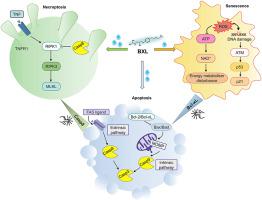当前位置:
X-MOL 学术
›
Chem. Biol. Interact.
›
论文详情
Our official English website, www.x-mol.net, welcomes your
feedback! (Note: you will need to create a separate account there.)
Different concentrations of betaxolol switch cell fate between necroptosis, apoptosis, and senescence in human corneal stromal cells
Chemico-Biological Interactions ( IF 4.7 ) Pub Date : 2024-02-05 , DOI: 10.1016/j.cbi.2024.110898 Jing-Yu Sun 1 , Jun Zhao 1 , Yue Qiu 1 , Ting-Jun Fan 1
Chemico-Biological Interactions ( IF 4.7 ) Pub Date : 2024-02-05 , DOI: 10.1016/j.cbi.2024.110898 Jing-Yu Sun 1 , Jun Zhao 1 , Yue Qiu 1 , Ting-Jun Fan 1
Affiliation

|
Betaxolol is commonly used to manage glaucoma in clinical practice. However, its long-term use may damage the cornea. Thus, the cytotoxicity and mechanisms of betaxolol in human corneal stromal cells (HCSCs) warrant further study. In this study, we used HCSCs and o rabbit corneal models to investigate betaxolol cytotoxic effects and mechanism of action. At near-clinical concentrations (0.28% and 0.14%), betaxolol inhibited caspase-8 activity, activated receptor-interacting protein kinase (RIPK)1, RIPK3, and mixed-spectrum kinase-like domain (MLKL), and phosphorylated MLKL to induce necroptosis in HCSCs. Similarly, moderate concentrations of betaxolol (0.07%–0.0175%) activated caspase-8 to trigger the exogenous apoptotic pathway. Through the intrinsic apoptotic pathway, betaxolol upregulated the expression of Bcl-2 family apoptotic proteins Bax and Bad and downregulated that of anti-apoptotic proteins Bcl-2 and Bcl-xL. This subsequently disrupted the mitochondrial membrane potential and cytoplasmic transfer of cytochrome and apoptosis-inducing factor, activated caspase-9, and induced apoptosis in HCSCs. Furthermore, continuous treatment with low betaxolol concentrations (0.00875%) for three generations of HCSCs prevented apoptosis by promoting the expression of Bcl-xL and suppressing that of Bax. However, its toxic effects initiated cellular senescence by increasing reactive oxygen species, leading to the disruption of energy metabolism and DNA damage. Finally, clinical concentrations of betaxolol had a pro-apoptotic effect on rabbit corneal stromal cells . These results suggest that betaxolol induces cytotoxicity in a concentration-dependent manner in HCSCs, and that caspase-8 and Bcl-2 family proteins may be critical switches in the conversion of different HCSC death mechanisms.
中文翻译:

不同浓度的倍他洛尔改变人角膜基质细胞坏死性凋亡、凋亡和衰老之间的细胞命运
倍他洛尔在临床实践中通常用于治疗青光眼。但长期使用可能会损伤角膜。因此,倍他洛尔对人角膜基质细胞(HCSC)的细胞毒性和机制值得进一步研究。在本研究中,我们使用 HCSC 和兔角膜模型来研究倍他洛尔的细胞毒性作用和作用机制。在接近临床浓度(0.28% 和 0.14%)时,倍他洛尔抑制 caspase-8 活性,激活受体相互作用蛋白激酶 (RIPK)1、RIPK3 和混合谱激酶样结构域 (MLKL),并使 MLKL 磷酸化以诱导HCSC 中的坏死性凋亡。同样,中等浓度的倍他洛尔(0.07%–0.0175%)激活caspase-8以触发外源性细胞凋亡途径。通过内在凋亡途径,倍他洛尔上调Bcl-2家族凋亡蛋白Bax和Bad的表达,下调抗凋亡蛋白Bcl-2和Bcl-xL的表达。这随后扰乱了线粒体膜电位以及细胞色素和凋亡诱导因子的细胞质转移,激活了 caspase-9,并诱导 HCSC 凋亡。此外,连续用低浓度倍他洛尔(0.00875%)处理三代HCSC,通过促进Bcl-xL的表达并抑制Bax的表达来防止细胞凋亡。然而,其毒性作用通过增加活性氧来引发细胞衰老,导致能量代谢破坏和 DNA 损伤。最后,临床浓度的倍他洛尔对兔角膜基质细胞具有促凋亡作用。 这些结果表明,倍他洛尔在 HCSC 中以浓度依赖性方式诱导细胞毒性,并且 caspase-8 和 Bcl-2 家族蛋白可能是不同 HCSC 死亡机制转换的关键开关。
更新日期:2024-02-05
中文翻译:

不同浓度的倍他洛尔改变人角膜基质细胞坏死性凋亡、凋亡和衰老之间的细胞命运
倍他洛尔在临床实践中通常用于治疗青光眼。但长期使用可能会损伤角膜。因此,倍他洛尔对人角膜基质细胞(HCSC)的细胞毒性和机制值得进一步研究。在本研究中,我们使用 HCSC 和兔角膜模型来研究倍他洛尔的细胞毒性作用和作用机制。在接近临床浓度(0.28% 和 0.14%)时,倍他洛尔抑制 caspase-8 活性,激活受体相互作用蛋白激酶 (RIPK)1、RIPK3 和混合谱激酶样结构域 (MLKL),并使 MLKL 磷酸化以诱导HCSC 中的坏死性凋亡。同样,中等浓度的倍他洛尔(0.07%–0.0175%)激活caspase-8以触发外源性细胞凋亡途径。通过内在凋亡途径,倍他洛尔上调Bcl-2家族凋亡蛋白Bax和Bad的表达,下调抗凋亡蛋白Bcl-2和Bcl-xL的表达。这随后扰乱了线粒体膜电位以及细胞色素和凋亡诱导因子的细胞质转移,激活了 caspase-9,并诱导 HCSC 凋亡。此外,连续用低浓度倍他洛尔(0.00875%)处理三代HCSC,通过促进Bcl-xL的表达并抑制Bax的表达来防止细胞凋亡。然而,其毒性作用通过增加活性氧来引发细胞衰老,导致能量代谢破坏和 DNA 损伤。最后,临床浓度的倍他洛尔对兔角膜基质细胞具有促凋亡作用。 这些结果表明,倍他洛尔在 HCSC 中以浓度依赖性方式诱导细胞毒性,并且 caspase-8 和 Bcl-2 家族蛋白可能是不同 HCSC 死亡机制转换的关键开关。













































 京公网安备 11010802027423号
京公网安备 11010802027423号